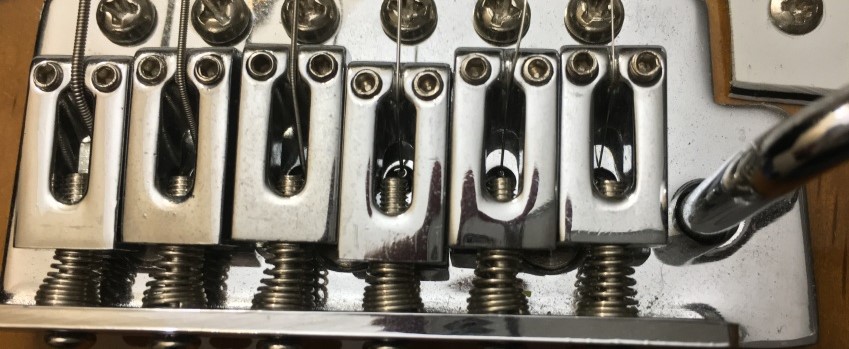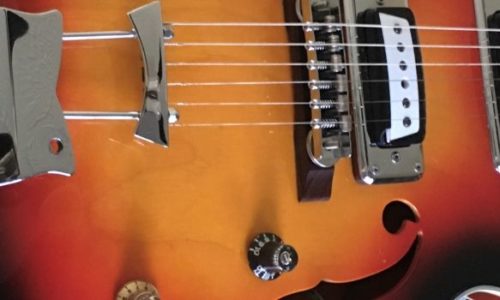Stratocaster Tremolo Setup – Floating vs. Decked vs. Blocked

Tremolo Options, Floating vs. Decked vs. Blocked
This article is written to demystify the three ways to set-up a Fender Stratocaster tremolo bridge. Learn about floating, decking, and blocking a Stratocaster bridge.
Meet the Whammy Bar
We’re starting this article with comments on the whammy bar. The reason is, if and how you use the trem arm largely determines which option is best for you.
The standard tremolo bridge offers functionality to be creative with your playing. Specifically, having a whammy bar, aka tremolo arm, allows you to lowers or increase string tension. Changing string tension varies the pitch of whatever note you are playing.
How does a whammy bar work? The Guitar World website has a great article on whammy bars history, use, and design variations. The article sums it up by stating, “This is achieved by manipulating a metal arm attached to the bridge or tailpiece. You can get some pretty insane sounds from the hardware – like dive-bombs, motorcycle revving, squeals, animal sounds, and much more – as well as more subtle dives and flutters.”1
When to Your Tremolo Setup
Changes to your tremolo will affect tuning, intonation, and (depending on what you do), how well your guitar stays tune when you do pull-ups and dives. The ideal time to change the way your tremolo functions is when you do a guitar setup service. It’s worth mentioning, no matter which way you set up your trem, it’s not permanent. You can easily change how your tremolo works anytime you do a setup.
The Stratocaster Tremolo
This article is generally written with the Stratocaster Tremolo in mind. A Floyd Rose tremolo system has a unique design that requires several differences in how to set it up.
HELPFUL TIP If you have a guitar with a thin trem block (i.e., older MIM Stratratocaster, Squier Stratocaster, etc.) you can get a remarkable increase in sustain if you upgrade your trem block. This is a relatively easy upgrade mod that can be done as part of your setup.
How do block thickness and material affect tone? Generally, replacing a thin zinc trem block with a thicker block of steel or brass will greatly improve sustain (think density and mass). For those interested we recommend taking time to visit the FU-Tone.com website. They promote the difference in this manner, “FU-Tone Tremolo Brass Blocks for Fender Stratocaster Strats. Brass Block Upgrades increase sustain, clarity, definition, and warmth. FU-Tone is the ultimate in tonal and performance upgrades for your guitar.”. If you’re unsure which block to buy for your guitar, simply reach out to their customer service people.2
Floating Tremolo
What is a Floating Tremolo?
A floating tremolo bridge setup enables the trem arm to have full movement for pull-ups and dives. With a floating tremolo you can make quickly changes to your guitars’ pitch up or down. A floating trem is set in a way that it balances string tension with spring resistance. Typically, the position of your bridge plate will be parallel to the body and approximately 1/8″ higher than the body.
What to Expect with a Floating Trem
The top drawbacks to a floating trem are tuning instability (especially with bends and pull-ups), and the least sustain of the three options.
Another downside is what happens when you break a string or bend a string. When your guitar setup was done, the tech balanced the trem based on (total) string tension. With a floating trem, when you break or bend a string that balance is substantially altered. This can cause all remaining strings to no longer be in tune. If you’re performing, this can be a very unpleasant moment.
An article on The GuitarPages.com describes it in this way; on bending strings, “When you play two notes at the same time and bend one of those strings, a floating bridge will allow the non-bended string to loosen and go flat. To hear this for yourself, pluck a note then bend the string next to it without plucking it. You’ll hear the original not go flat as the bridge is pulled forward from the bending pressure.”, and on breaking a string, “An often overlooked downside of a floating bridge is that a broken string will send the other 5 strings way out of tune.”3
Decked Tremolo
What is a Decked Tremolo?
A decked tremolo bridge setup limits trem arm partially restricts the tremolo arm movement. Decking a trem is done by increasing the resistance from the springs and claw to pull the bridge plate flush with the body.
What to Expect with a Decked Trem
Compared to a floating trem, tuning stability is more reliable and sustain is much improved.
Blocked Tremolo
What is a Blocked Tremolo?
A blocked tremolo bridge setup totally restricts the trem arm functionality. Basically, just keep the arm in your guitar case because you won’t be using it. Blocking a trem is done by fitting a wood block between the trem block and guitar body.
Of the three options, blocking your trem offers the best tuning stability and optimal sustain.
What to Expect with a Blocked Trem
A blocked trem effectively functions like a hardtail bridge. The upside is you can expect great tuning stability and optimal sustain from your guitar.
How Does Trem Setup Affect Sustain?
The video below, produced by Darrell Braun Guitar, and available on YouTube, does a wonderful job of explaining how floating, decking, and blocking impact the tone on a Stratocaster. We definitely recommend watching this 10 minute video.
Changing Strings and Tuning
If you’re going with a floating trem, and change string sizes, chances are you will need to do a setup for proper tuning and intonation. Sometimes, simply changing the brand of string but using the same size strings can cause issues. Your guitar setup was done with a particular type and size string set. If you make changes that effect tension , then you have affected the setup.
About Your Tremolo Springs
Tremolo springs. This is an element that is largely misunderstood and often abused. People sometimes add more springs, change spring positions, and otherwise alter tension without understanding what they are doing. There are things you need to know before altering your trem springs and claw.
Firstly, relative to a Strat tremolo, the two screws for the claw should not be screwed all of the way in. These are adjustment screws used to fine tune spring tension affecting the bridge.
If you want to deck your trem or block your trem, you may add more or stronger springs. The idea is to pull the bridge down to the surface of the guitar body. Obviously, if you want to block your trem you need to fit and install a block between the trem block and cavity wall.
If you want a floating trem you usually need only three springs. They should be spaced apart evenly, and installed to be 90 degrees to the trem block (not angled). Some techs may angle the middle spring a bit to increase tension on the low side. This is because the low-side (larger strings) add more tension than the lighter, high-side strings. The thinking is this allows the springs to compensate for the difference and promote a better balanced bridge. To learn more about guitar trem springs, watch this video titled How Many Springs Do I Need?
About the Tremolo Cavity Cover
So, do you really need a tremolo cavity cover? Technically, you do not need a cavity cover. It does give your guitar a more finished look, and can keep debris out of the cavity. Ask this question in a forum and you’ll get countless advice. For us, the guitar design engineers said it should be there, so we advocate for it to be used as intended.
Floating, decked, or blocked, it’s your choice. It’s not a permanent change so feel free to try all three and see what works for you.
FOOTNOTES
- 1 Brandon Stoner, “Guitar whammy bars: what you need to know”, September 27, 2021, Available from Guitar World
- 2 FU-Tone, “Big Blocks ST”, May 1, 2021, Available from FU-Tone
- 3 Guitar Tech, “Float, Deck, or Block: An Exploration of The Strat Bridge”, June 2, 2020, Available from The Guitar Pages




Great info, especially explaining how each type of setup affects tuning stability.